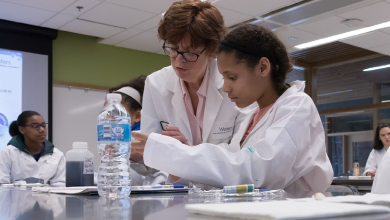
Our overarching goal is to increase student STEM motivation, improve STEM identity, and increase the interest in STEM careers.
A new program will soon be offered at Bridgewater State University to encourage girls to pursue an education in STEM subjects and demonstrate that opportunities exist for women in what have traditionally been male-dominated fields.
Jennifer Aizenman, director of the Center for the Advancement of STEM Education (CASE), was recently awarded a Community Action Grant from the American Association of University Women to fund the project.
“This is an opportunity for us to get funding to improve STEM education for students who are underserved,” Aizenman said.
STEM stands for science, technology, engineering, and mathematics. Women have long been underrepresented in these fields.
The new program, Engineering a Better World, will invite students from Our Sisters’ School, an all-girls school in New Bedford, to work with BSU faculty and undergraduates to learn more about STEM subjects and careers in the field, as well as all BSU has to offer.
Together with BSU faculty, CASE is in the planning stages of the program, which will be geared toward students in grades 7 and 8.
As part of the program, set to launch next semester, students will use engineering concepts to better understand how to respond to natural disasters.
They will explore what considerations are important following natural disasters, such as an earthquake or a building collapse, investigating ways people can still communicate when power is lost and the kinds of public health issues that can result from large-scale events. The program will also investigate preventative measures of such disasters.
“With climate change there is an increase in the frequency of storms,” said CASE Assistant Director Kim McCoy. “Students will look at what can be done to prevent the huge impacts created by natural disasters.”
The program includes two campus visits, where students will get a glimpse of what college life is like.
“We won’t just be doing STEM content and hands-on activities, but we also give the students a chance to come and see themselves on a college campus, particularly at BSU where math and science are so strong,” Aizenman said.
A recent survey indicated that CASE outreach programs, such as science fairs and open lab nights, have drawn students to enroll at BSU.
“We kept hearing back from students that the reason they came here was because they attended one of our programs,” Aizenman said.
McCoy believes part of the reason is because CASE uses undergraduates to help run many events. Having that peer-to-peer interaction is key, she said. It also gives undergraduate students the opportunity to serve in leadership positions.
“We have integrated undergraduate students in as many programs as possible,” Aizenman said. “When students come to campus for STEM career day or science fairs, we make sure we have undergraduates available,” she said.
According to McCoy, many CASE programs are also taught by retired teachers, adding another layer of community outreach.
“I love the fact that we are able to generationally impact multiple audiences. From preschoolers to 80-year-olds, we’re having a significant impact on many people’s lives,” she said.
Engineering a Better World adds another way CASE can continue to be impactful, Aizenman said.
“Our overarching goal is to increase student STEM motivation, improve STEM identity, and increase the interest in STEM careers,” she said.